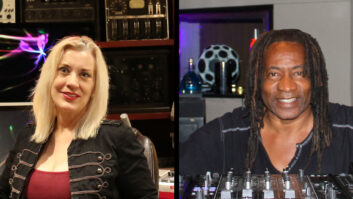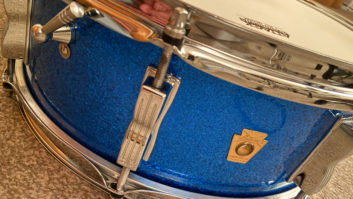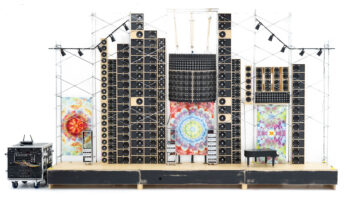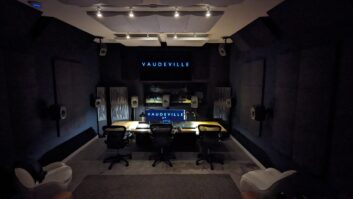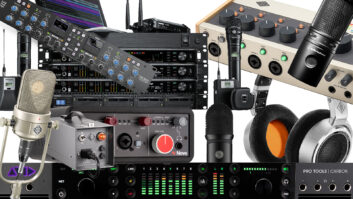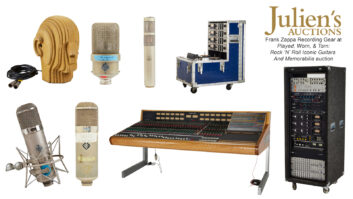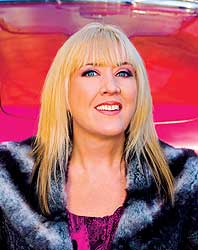
I found it up in an oven-hot attic in the middle of summer. The place reeked of bird crap. I was rummaging for treasure in an old music store, tip-toeing around in an area that was strictly off-limits to anyone but shop personnel, and I found this massively crazy amp literally stuffed between a pile of old marching-band tubas and a stack of Chinese violins. I knew it was something weird and special, covered in a thick layer of gray dust and pigeon excrement. A big old wood thing, built like a classic console television or something. It had an instrument jack on the front and two large round speakers pointing outward from a large tube.
I am bored with the typical. We all wake up in our boxy bedrooms and pour cereal out of a box, turn on the box to watch the news, climb into our box to drive to work. We tolerate our mundane existence as we pull our guitars out of boxes, connecting one box to another to make sound come out. Stomp on another box to make it sound groovy. So I was lucky to find a real gem that had nothing to do with traditional square guitar amplifier construction. My attic treasure was called a “Tuned Tube” and was like nothing I’d ever seen before. Either this designer was a genius or he was really freakin’ high. (Somehow, I think the latter applies here.) Built to fit into the modern look of the early ’60s living room, it was a solid-state amp designed around a large physical “tube” with speakers mounted at both ends pointing outward. It had cabinet-quality wooden reflecting panels on hinges used to aim the sound coming out of the tube, controlled with small adjustable ropes. (Ropes?!) With these “reflectors,” you could set up the amp in your living room, carefully focusing the sound at your favorite chair. Despite its strangeness, the Tuned Tube really did sound amazing! Deep tremolo and spring reverb made this a favorite clean tone played by Mike Campbell during our Johnny Cash sessions, among many other great projects.

Maestro’s Rover Amp
Photo: Courtesy Brian Charles
It looked to have been stored there since it was new, with original store tags still attached, but someone had cannibalized every control knob off of the front. I excitedly dragged the huge thing down three flights of stairs, as whisperingly quiet as possible, before presenting it to the old geezer at the counter. “How much is this?” He looked at me covered from head to toe in sweat and soot, knowing I’d been snooping around where I shouldn’t. “Well,” he said as he gave me the stink-eye, “for you, $200.” I couldn’t resist. This was to be my biggest guitar amp discovery of 1994.

Sylvia checking out the 3rd Power HLH 312 speaker ultra-stack at NAMM
More than just choosing the type of wood and speaker element used, the construction of a speaker cabinet for guitar is an art that can take many forms. And why not? Some shapes have purpose. And some seem to be experiments with no reality behind them. Vox had some interesting designs in the late ’60s and early ’70s, incorporating stylized angled cabinets, and the Acoustic Corporation (best known for its successful folded-horn bass rigs in the ’70s) had some really unusual designs, including my Tuned Tube.

The Acoustic Tuned Tube amplifier in action during the Lustra sessions
Japanese company Teisco also had an amp that was designed to fit into your living room décor. About the size of a small end table, the cylindrical Check Mate 30 amp had the speaker pointed straight up, reflected out to the sides with a plastic cone. This clean, solid-state amp also had a strong tremolo and sounded real good, but with its cheesy ’70s fake-plastic wood wrap, it was hard to take the amp seriously. Similarly, Maestro had a cylindrical UFO hatbox type of amp in the ’70s that could be mounted on the top of a mic stand. The Rover sales pitch boasted a compact design that would spread the sound throughout the room, similar to the Bose speakers of the era. Both of these instrument manufacturers attempted to buck the trend and come up with the geodesic dome of guitar amplifiers that would revolutionize the way speakers were built, but like the domes, they never really made that big of an impact. But this is not a reason to give up on ingenuity!

Teisco’s Check Mate 30 end-table amp design
Not quite yet. Like any great restaurant, each manufacturer has its own way of dishing up the guitar amplifier/speaker combination—and some meals are downright unusual and exotic! Take 3rd Power, for instance: Here is an American company that is known for its use of triangles in the amplifiers’ design, and these rigs look very different. Jamie Scott, the company’s founder and head designer, has a very specific reason why the speakers are shaped the way they are. He explains that professional recording studios are built with no parallel walls, so why would you have parallel walls in guitar cabinet construction? Good point—though I never stuck to that “no parallel walls” rule in my studio. Needless to say, these triangular guitar cabinets are made from Baltic birch loaded with vintage 30 speakers, and they sound terrific. The biggest drawback to having the 3rd Power HLH 312 speaker cabs would be that they are awkward as hell to carry around, and you need at least three of them to have a proper stack to set your head on. Ahhh, but they look super-cool and have been big hits at the NAMM shows.
The truth is, big old square cabinets and combos actually sound good. They push air. They resonate. They are structurally sound. They fit along a wall. They stack nicely. Boxes are okay, after all. They are hard to avoid. They make us feel safe. And when all is said and done, we will probably be spending eternity in the ground in one anyways.
Sylvia Massy is the unconventional producer and engineer of artists including Tool, System of a Down, Johnny Cash, Red Hot Chili Peppers, Tom Petty and Prince. She is a member of the NARAS P&E Wing Steering Committee and Advisory Boards, and is a resident producer at RadioStar Studios in Weed, Calif.

